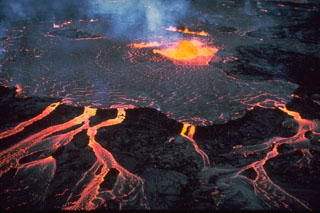Report on Kilauea (United States) — 30 May-5 June 2018
Smithsonian Institution / US Geological Survey
Weekly Volcanic Activity Report, 30 May-5 June 2018
Managing Editor: Sally Sennert.
Please cite this report as:
Global Volcanism Program, 2018. Report on Kilauea (United States) (Sennert, S, ed.). Weekly Volcanic Activity Report, 30 May-5 June 2018. Smithsonian Institution and US Geological Survey.
Kilauea
United States
19.421°N, 155.287°W; summit elev. 1222 m
All times are local (unless otherwise noted)
HVO reported that the eruption at Kilauea’s Lower East Rift Zone (LERZ) and at Overlook Crater within Halema`uma`u Crater continued during 30 May-6 June. Lava fountaining and spatter was concentrated at Fissure 8, feeding lava flows that spread through Leilani Estates and Lanipuna Gardens subdivisions, and reached the ocean at Kapoho Bay. Fissures 22, 6, and 13 were periodically active on 30 May, and fissures 6/13 spattered on 4 June. Sluggish lava flows were present around Fissure 18.
Inward slumping of the crater rim and walls of Halema`uma`u continued, and earthquake activity beneath the caldera was mostly high, as the summit area adjusted to the withdrawal of magma from Overlook Crater. Passive degassing of SO2 from the summit decreased, but emission rates were high enough to impact air quality downwind. Ash emissions were intermittent and low, though around 1100 on 30 May an ash plume rose to 3.6 km (12,000 ft) a.s.l. A small explosion was detected at 1339 on 1 June. A preliminary M 5.5 earthquake was recorded at 1550 on 3 June, producing an ash plume that rose to 2.4 km (8,000 ft) a.s.l. A small explosion and accompanying M 5.5 earthquake was detected at 0432 on 5 June; an ash plume rose to 1.6 km (5,100 ft) a.s.l.
During the beginning of the reporting period Fissure 8 generated tall lava fountains, rising 80 m, and some secondary fountains that rose 18 m. Pele's hair and other volcanic glass from the high fountaining fell in areas W of the fissure and within Leilani Estates. A small (30 m high) spatter cone formed at the downwind side of the fountain. Volcanic gas emissions from the fissures were very high; trade winds blew vog to the S and W parts of the island.
The lava flow fed by Fissure 8 advanced NE at a rate of 550 m/hour during 29-30 May, but then slowed to 90 m/hour on 31 May. High eruption rates led to the formation of a leveed channel along the W edge of the lava flow; small overflows from the channel occurred along its length. On 2 June lava flowed around the N part of Kapoho Crater and then turned S, entering the Vacationland neighborhood. At 0700 the flow front had entered Kapoho Beach Lots, moving about 75 m/hour. Lava entered Green Lake (70 m x 120 m in dimension, and 60 m deep) at 1000, creating a large steam plume. By 1500 lava had completely filled the lake and boiled off the water. Locals reported that lava (with a flow front 800 m wide) entered the ocean at Kapoho Bay around 2230. By late afternoon on 4 June lava had built a delta extending almost 700 m into the bay.
Overnight during 4-5 June lava fountaining at Fissure 8 was less vigorous, with a maximum height of 55 m. By 0630 on 5 June lava had completely filled Kapoho Bay, creating a new coastline 1.1 km away from the former coastline. To the S lava had overtaken most of the Vacationland subdivision and was entering the tidepools. All but the northern part of Kapoho Beach Lots had been covered.
Geological Summary. Kilauea overlaps the E flank of the massive Mauna Loa shield volcano in the island of Hawaii. Eruptions are prominent in Polynesian legends; written documentation since 1820 records frequent summit and flank lava flow eruptions interspersed with periods of long-term lava lake activity at Halemaumau crater in the summit caldera until 1924. The 3 x 5 km caldera was formed in several stages about 1,500 years ago and during the 18th century; eruptions have also originated from the lengthy East and Southwest rift zones, which extend to the ocean in both directions. About 90% of the surface of the basaltic shield volcano is formed of lava flows less than about 1,100 years old; 70% of the surface is younger than 600 years. The long-term eruption from the East rift zone between 1983 and 2018 produced lava flows covering more than 100 km2, destroyed hundreds of houses, and added new coastline.
Source: US Geological Survey Hawaiian Volcano Observatory (HVO)

